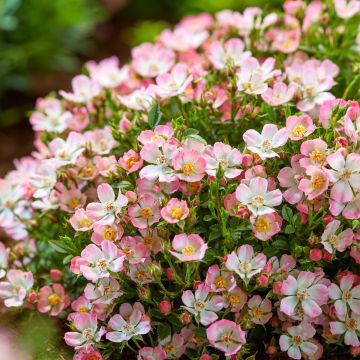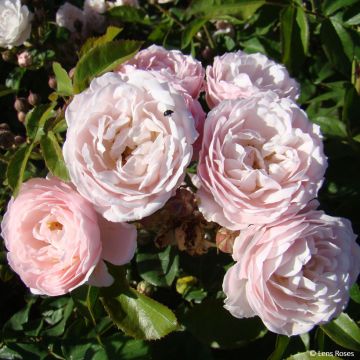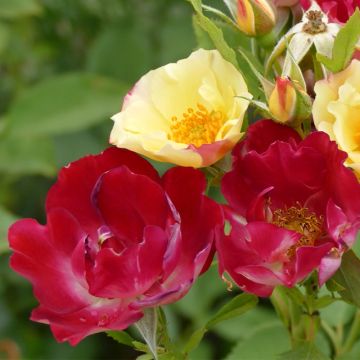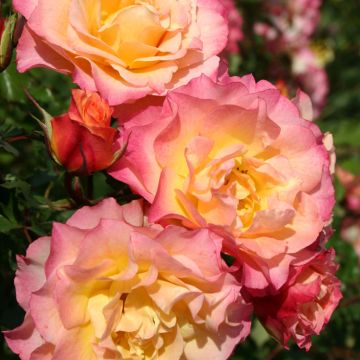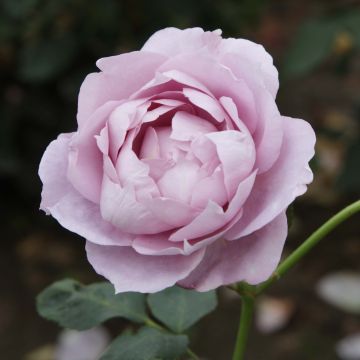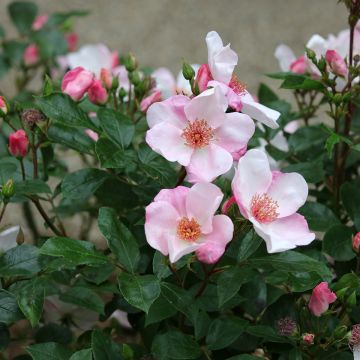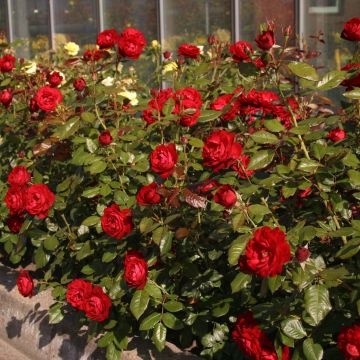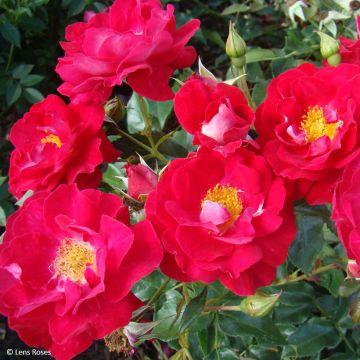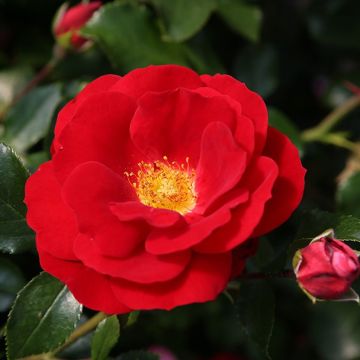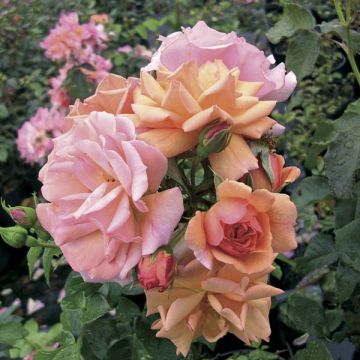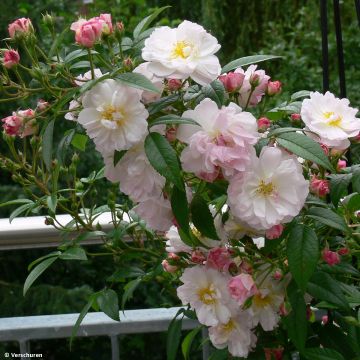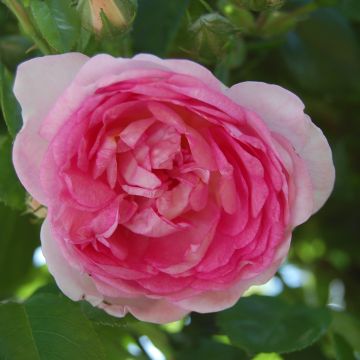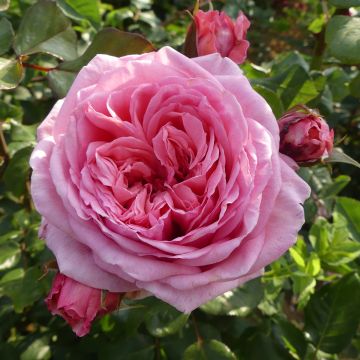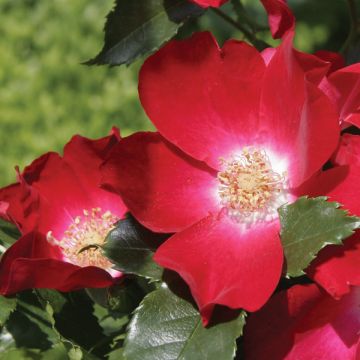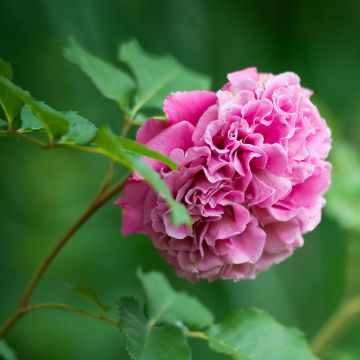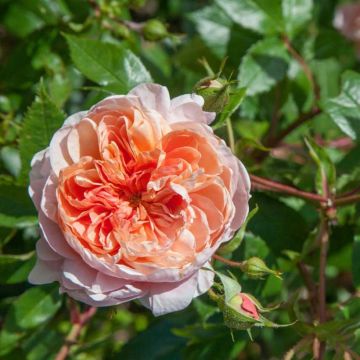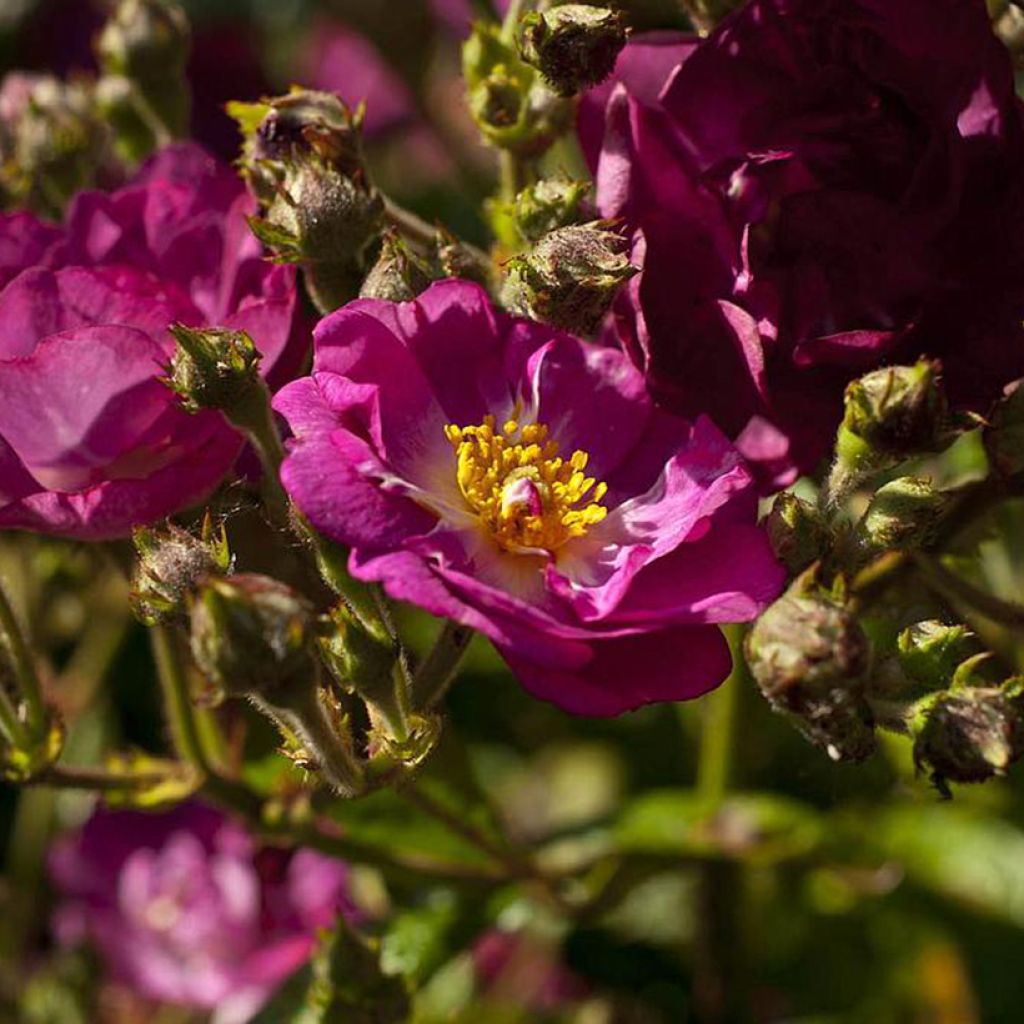

Rosier arbustif Violet Hood
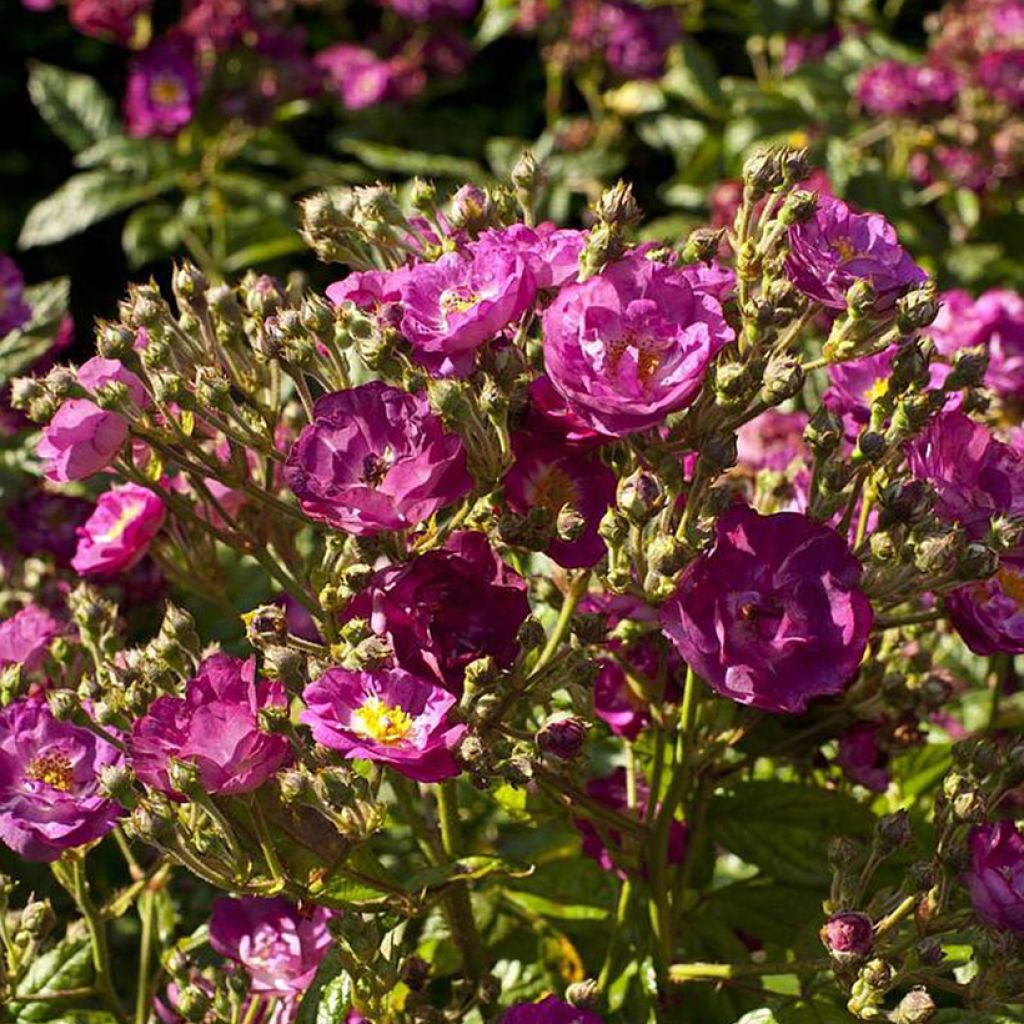

Rosier arbustif Violet Hood
Rosa Violet Hood - Shrub Rose
Rosa Violet Hood
shrub rose
This item cannot be shipped to the selected country
Delivery charge from €5.90
Delivery charge from €5.90
More information
Schedule delivery date,
and select date in basket
This plant carries a 24 months recovery warranty
More information
We guarantee the quality of our plants for a full growing cycle, and will replace at our expense any plant that fails to recover under normal climatic and planting conditions.
From €5.90 for pickup delivery and €6.90 for home delivery
Express home delivery from €8.90.
From €5.90 for pickup delivery and €6.90 for home delivery
Express home delivery from €8.90.
Does this plant fit my garden?
Set up your Plantfit profile →
Description
Rosa Violet Hood Shrub Rose truly stands out with the unusual colour of its flowers and foliage. It is a descendant of the Robin Hood roses, rich in flowers, and Baby Faurax, a polyantha with a pretty mauve colour. The result is a vigorous bush with a flexible and dense habit that is adorned with large clusters of semi-double flowers in a deep lavender violet colour. Its dark foliage with a touch of brown is interesting, as are its red hips in autumn. The Violet Hood rose can be used as a specimen plant, in groups, in a perennial bed, in a small flowering hedge, or in a large pot.
The Violet Hood rose was bred by Louis Lens in 1975. It descends from the musk rose (Rosa x moschata) through its parent Robin Hood. Similar to polyanthas and floribundas, musk roses produce flowers in clusters, but their colours are more refined and they have a more flexible and graceful habit. 'Violet Hood' has rapid growth and a bushy, compact, and flexible habit. Eventually, this bush reaches a height of 1m (3ft) to 1.25m (4ft) with a spread of 90cm (35in). Its bronze-tinted green leaves are divided into relatively fine leaflets. This deciduous foliage, absent in winter, is quite resistant to rose diseases. It flowers in June and again in September-October with large clusters composed of numerous small semi-double flowers, 3-4cm (1-2in) in diameter. Each flower opens in a purplish violet shade around an irregularly streaked white centre, with well-exposed yellow stamens for bees and pollinators. After pollination, small round hips form and turn red when ripe.
The Violet Hood shrub rose is a wildlife-friendly rose that nourishes bees in summer and birds in autumn, with its numerous small hips. Easy to grow and undemanding, it thrives in well-prepared soil in full sun. Plant it in a rose or flowering shrub bed, with white, mauve, or pink roses, or in a border with robust perennials such as Chinese peonies, perennial geraniums, salvias, etc. It forms a beautiful composition with "blue" roses such as Minerva, Blue Girl, or Pacific Dream. Also consider planting it with a climbing herbaceous clematis that will weave through its branches.
Award: Silver Medal at Courtrai in 1978.
Report an error about the product description
Plant habit
Flowering
Foliage
Botanical data
Rosa
Violet Hood
Rosaceae
shrub rose
Cultivar or hybrid
Other Polyantha clustered Roses
Planting and care
To plant your Violet Hood rose, dig the soil to a depth of 25 cm (10in) and add a base fertiliser such as bonemeal. Remove your rose from its pot and position by covering the top of the root ball with 3 cm (1in) of soil, fill in the hole and water generously to eliminate air pockets. In dry weather, water regularly for a few weeks to aid rooting. Provide your rose with special rose fertiliser that stimulates flowering.
Roses are often stained or unsightly at the end of summer, but this is not a problem for their development. These spots are not harmful to the rose, it is a natural phenomenon.
Planting period
Intended location
Care
-
, onOrder confirmed
Reply from on Promesse de fleurs
Roses by producer
Haven't found what you were looking for?
Hardiness is the lowest winter temperature a plant can endure without suffering serious damage or even dying. However, hardiness is affected by location (a sheltered area, such as a patio), protection (winter cover) and soil type (hardiness is improved by well-drained soil).

Photo Sharing Terms & Conditions
In order to encourage gardeners to interact and share their experiences, Promesse de fleurs offers various media enabling content to be uploaded onto its Site - in particular via the ‘Photo sharing’ module.
The User agrees to refrain from:
- Posting any content that is illegal, prejudicial, insulting, racist, inciteful to hatred, revisionist, contrary to public decency, that infringes on privacy or on the privacy rights of third parties, in particular the publicity rights of persons and goods, intellectual property rights, or the right to privacy.
- Submitting content on behalf of a third party;
- Impersonate the identity of a third party and/or publish any personal information about a third party;
In general, the User undertakes to refrain from any unethical behaviour.
All Content (in particular text, comments, files, images, photos, videos, creative works, etc.), which may be subject to property or intellectual property rights, image or other private rights, shall remain the property of the User, subject to the limited rights granted by the terms of the licence granted by Promesse de fleurs as stated below. Users are at liberty to publish or not to publish such Content on the Site, notably via the ‘Photo Sharing’ facility, and accept that this Content shall be made public and freely accessible, notably on the Internet.
Users further acknowledge, undertake to have ,and guarantee that they hold all necessary rights and permissions to publish such material on the Site, in particular with regard to the legislation in force pertaining to any privacy, property, intellectual property, image, or contractual rights, or rights of any other nature. By publishing such Content on the Site, Users acknowledge accepting full liability as publishers of the Content within the meaning of the law, and grant Promesse de fleurs, free of charge, an inclusive, worldwide licence for the said Content for the entire duration of its publication, including all reproduction, representation, up/downloading, displaying, performing, transmission, and storage rights.
Users also grant permission for their name to be linked to the Content and accept that this link may not always be made available.
By engaging in posting material, Users consent to their Content becoming automatically accessible on the Internet, in particular on other sites and/or blogs and/or web pages of the Promesse de fleurs site, including in particular social pages and the Promesse de fleurs catalogue.
Users may secure the removal of entrusted content free of charge by issuing a simple request via our contact form.
The flowering period indicated on our website applies to countries and regions located in USDA zone 8 (France, the United Kingdom, Ireland, the Netherlands, etc.)
It will vary according to where you live:
- In zones 9 to 10 (Italy, Spain, Greece, etc.), flowering will occur about 2 to 4 weeks earlier.
- In zones 6 to 7 (Germany, Poland, Slovenia, and lower mountainous regions), flowering will be delayed by 2 to 3 weeks.
- In zone 5 (Central Europe, Scandinavia), blooming will be delayed by 3 to 5 weeks.
In temperate climates, pruning of spring-flowering shrubs (forsythia, spireas, etc.) should be done just after flowering.
Pruning of summer-flowering shrubs (Indian Lilac, Perovskia, etc.) can be done in winter or spring.
In cold regions as well as with frost-sensitive plants, avoid pruning too early when severe frosts may still occur.
The planting period indicated on our website applies to countries and regions located in USDA zone 8 (France, United Kingdom, Ireland, Netherlands).
It will vary according to where you live:
- In Mediterranean zones (Marseille, Madrid, Milan, etc.), autumn and winter are the best planting periods.
- In continental zones (Strasbourg, Munich, Vienna, etc.), delay planting by 2 to 3 weeks in spring and bring it forward by 2 to 4 weeks in autumn.
- In mountainous regions (the Alps, Pyrenees, Carpathians, etc.), it is best to plant in late spring (May-June) or late summer (August-September).
The harvesting period indicated on our website applies to countries and regions in USDA zone 8 (France, England, Ireland, the Netherlands).
In colder areas (Scandinavia, Poland, Austria...) fruit and vegetable harvests are likely to be delayed by 3-4 weeks.
In warmer areas (Italy, Spain, Greece, etc.), harvesting will probably take place earlier, depending on weather conditions.
The sowing periods indicated on our website apply to countries and regions within USDA Zone 8 (France, UK, Ireland, Netherlands).
In colder areas (Scandinavia, Poland, Austria...), delay any outdoor sowing by 3-4 weeks, or sow under glass.
In warmer climes (Italy, Spain, Greece, etc.), bring outdoor sowing forward by a few weeks.


































